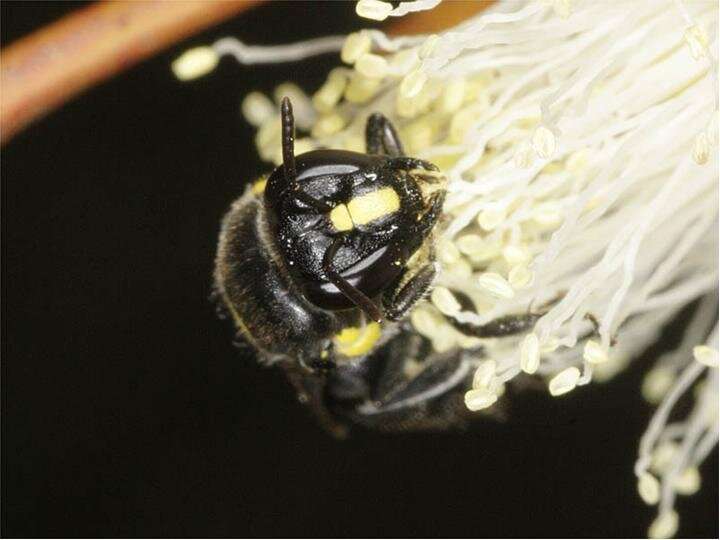This article has been reviewed according to Science X's editorial process and policies. Editors have highlighted the following attributes while ensuring the content's credibility:
fact-checked
peer-reviewed publication
trusted source
proofread
Weird world of Aussie bees: How one species creates gender balance in the nest

New Flinders University research gives insights into the fascinating world of Australian native bees, finding that one highly evolved species has been shaped by an unusual battle between male and female offspring numbers.
The article just published in Biology Letters adds another twist to the colorful and varied evolution and ecology of hundreds of native bee species that rely on cooperative colonies to survive often harsh environments.
The bee in focus, Amphylaeus morosus (known as the "Capricious Masked Bee"), is characterized by a social system involving one highly reproductive female "queen" and non-reproductive female "guards," which makes it a model species for studying social evolution in insects.
Ever since the days of Darwin, one of the big biological mysteries has been how sterile workers evolve in cooperative social species; how can genes for sterility persist when sterile individuals have no offspring?
"We now know that problem is largely explained by kin selection, where workers can pass on copies of their genes via brothers and sisters, instead of having their own offspring," says lead researcher, Flinders Ph.D. and entomologist Dr. Lucas Hearn.
But why do sterile workers evolve in some kinds of animals, like ants, bees and wasps, and only rarely in others?
"Part of the answer is the weird genetic system of Hymenoptera (ants, bees and wasps), where females are more closely related to their sisters than to their own babies, but much less related to their brothers.
"If female workers can rear their sisters, instead of their own babies or their brothers, this can provide a genetic 'edge' that favors sterility," he says.
However, it turns out that things are not always this simple.
Upon closer examination of the social bee A. morosus, Flinders University researchers have revealed an intriguing situation where queens, supported by helpful or "altruistic" guards in their nests, lay more offspring, but those extra offspring are always males.
"This is great for the queen, but not so good for the female guards because those extra offspring are her brothers and not closely related," says Dr. Hearn.
"However, the more guards in a population, the more excess males are produced and the less genetic value they have."
This could serve to illustrate the pinnacle of a very long evolutionary pathway which makes it unable to progress to a stage of further social complexity known as "eurosociality," which features nests with a single queen and a number of workers that don't reproduce.
This follows earlier research by Flinders showed that while altruistic guarding behavior in A. morosus can be explained by kin selection, guarding behavior was puzzlingly rare.
"Studying the benefit of these guards within the colony has also revealed unexpected complexity in social behavior that challenges the notion that sociality evolves in a linear and gradual way.
"This latest research provides an explanation for that puzzle, namely altruistic guarding behavior is only rewarding when it is rare. When it becomes common, all the excess male offspring become less valuable," say co-authors Flinders University Associate Professor Mike Schwarz and University of Adelaide Associate Professor Mark Stevens, a senior research scientist at the South Australian Museum.
"The Australian bee Amphylaeus morosus seems to have landed in a 'Goldilocks zone': not too little collective sociality and not too much—just the right amount," the researchers conclude.
Amphylaeus morosus makes its nests in the broken fern fronds of the rough tree fern Cyathea australis, which are densely spread throughout the Dandenong Ranges and Central Highlands regions of Victoria and more sporadically throughout montane habitats along the east coast of Australia.
It is the only known social species within the highly diverse Colletidae bee family, making it an ideal species to investigate how social behavior in insects first evolved.
More information: Lucas R. Hearn et al, The presence of a guard vicariously drives split sex ratios in a facultatively social bee, Biology Letters (2023). DOI: 10.1098/rsbl.2022.0528
Journal information: Biology Letters
Provided by Flinders University


















